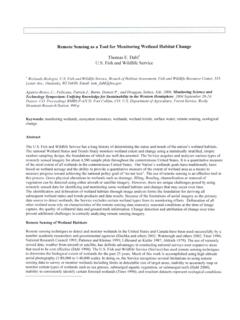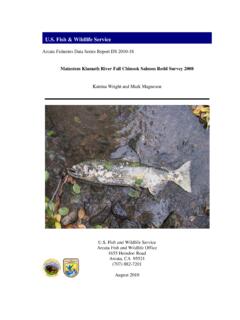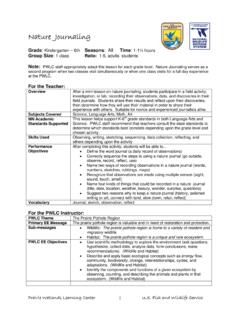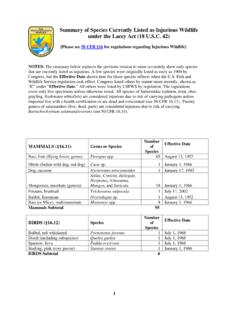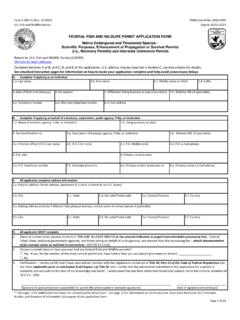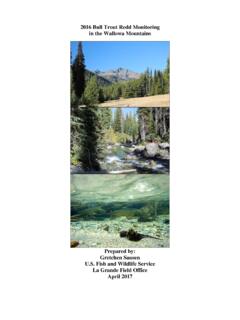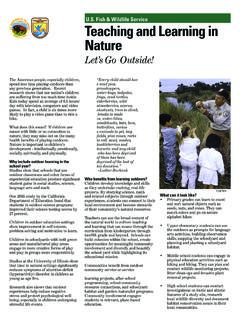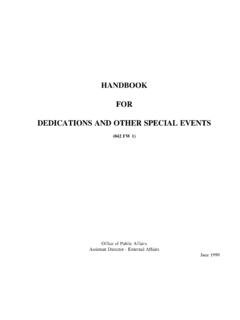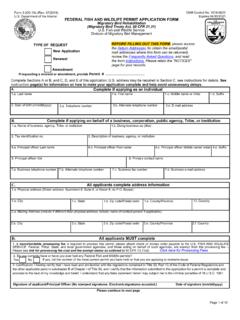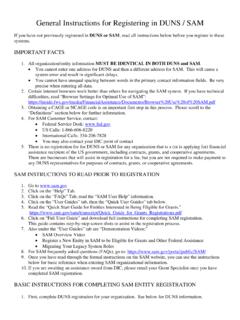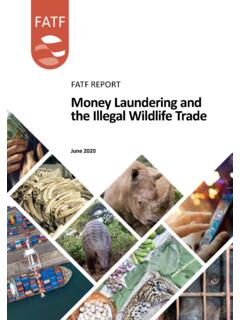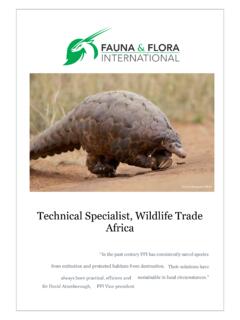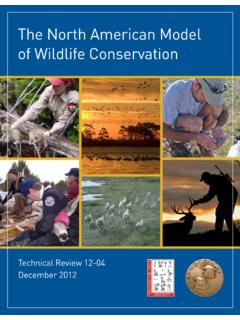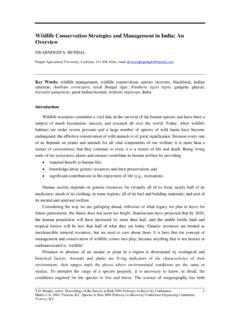Transcription of CITES Document Requirements - FWS
1 CITES Document Requirements Guidance for Importers and Exporters This factsheet provides a general overview of CITES Document Requirements and links the reader to more detailed information in our CITES regulations. See Federal Register 79 FR 30399 for the new 50 CFR Part 23 ( CITES ) regulations. You must have a valid CITES Document , including a CITES exemption Document , toengage in international trade in any CITES specimen except as provided below. You do not need a CITES Document if your specimen qualifies as exempt fromCITES. You may be required to demonstrate that your specimen qualifies as exempt. CITES documents must contain certain standardized information. This requirementapplies to all CITES documents issued by a Party or a non-Party except phytosanitarycertificates issued for artificially propagated plants or a customs declaration labelused for movement between registered scientific institutions.
2 There are specific Requirements for the CITES form itself whether the Document isissued by a Party or a non-Party. The CITES Document must contain either a purpose code or a written description ofthe purpose. Additional information is required for specific types of CITES documents such aspre-Convention certificates, annexes, or certificates of origin. The CITES Document must indicate a code for the source of the specimen. In addition to the standardized information identified above, non-Party documentsmust contain certain certifications on the face of the Document . A separate original or a true copy of a CITES Document must be issued before animport, introduction from the sea, export, or re-export occurs and the Document mustaccompany each shipment. No copy, including fax or electronic, may be used inplace of an original except for in-transit shipments or other limited circumstances.
3 We will accept a CITES Document as valid for import, introduction from the sea,export, or re-export only if the Document meets all the information Requirements (see through ) and certain conditions. We may request verification of a CITES Document from a foreign managementauthority before deciding whether to accept it for various reasons including certaincircumstances. CITES Document or CITES exemption Document means any certificate, permit, or other Document issued by a Management Authority of a Party or a competent authority of a non-Party whose name and address is on file with the Secretariat to authorize the international movement of CITES specimens. Specimen means any wildlife or plant, whether live or dead. This term includes any readily recognizable part, product, or derivative unless otherwise annotated in the Appendices. International trade means the import, introduction from the sea, export, or re-export across jurisdictional or international boundaries for any purpose whether commercial or noncommercial.
4 (d) CITES exemption documents. The following table lists the CITES exemption Document that you must obtain before conducting a proposed activity with an exempt specimen (other than specimens exempted under ). If one of the exemptions does not apply to the specimen, you must obtain a CITES Document as provided in paragraph (e) of this section. The first column in the following table alphabetically lists the type of specimen or activity that may qualify for a CITES exemption Document . The last column indicates the section of this part that contains information on the application procedures, provisions, criteria, and conditions specific to each CITES exemption Document , as follows: Type of specimen or activity Appendix CITES exemption Document Section (1) Artificially propagated plant (see paragraph (d)(4) of this section for an Appendix-I plant propagated for commercial purposes) I, II, or III CITES Document with source code A 1 (2) Artificially propagated plant from a country that has provided copies of the certificates, stamps, and seals to the Secretariat II or III Phytosanitary certificate with CITES statement1 (f) (3) Bred-in-captivity wildlife (see paragraph (d)(5) of this section for Appendix-I wildlife bred in captivity for commercial purposes) I, II, or III CITES Document with source code C 1 (4) Commercially propagated Appendix-I plant I CITES Document with source code D 1 (5)
5 Commercially bred Appendix-I wildlife from a breeding operation registered with the CITES Secretariat I CITES Document with source code D 1 (6) Export of certain marine specimens protected II CITES Document indicating that the (e) under a pre-existing treaty, convention, or international agreement for that species specimen was taken in accordance with provisions of the applicable treaty, convention, or international agreement (e) (7) Hybrid plants I, II, or III CITES Document unless the specimen qualifies as an exempt plant hybrid (8) Hybrid wildlife I, II, or III CITES Document unless the specimen qualifies as an exempt wildlife hybrid (9) In-transit shipment (see paragraph (d)(14) of this section for sample collections covered by an ATA carnet) I, II, or III CITES Document designating importer and country of final destination (10) Introduction from the sea under a pre-existing treaty, convention, or international agreement for that species II Document required by applicable treaty, convention, or international agreement, if appropriate (d) (11) Noncommercial loan, donation, or exchange of specimens between scientific institutions registered with the CITES Secretariat I, II, or III A label indicating CITES and the registration codes of both institutions and, in the United States, a CITES certificate of scientific exchange that registers the institution3 (12) Personally owned live wildlife for multiple cross-border movements I, II, or III CITES certificate of ownership2 (13)
6 Pre-Convention specimen I, II, or III CITES Document indicating pre-Convention status1 (14) Sample collection covered by an ATA carnet I4, II, or III CITES Document indicating sample collection2 (15) Traveling exhibition I, II, or III CITES Document indicating specimens qualify as pre-Convention, bred in captivity, or artificially propagated2 1 Issued by the Management Authority in the exporting or re-exporting country. 2 Issued by the Management Authority in the owner s country of usual residence. 3 Registration codes assigned by the Management Authorities in both exporting and importing countries. Are any wildlife or plants, and their parts, products, or derivatives, exempt? (a) All living or dead wildlife and plants in Appendix I, II, and III and all their readily recognizable parts, products, and derivatives must meet the Requirements of CITES and this part, except as indicated in paragraph (b) of this section.
7 (b) The following are exempt from the Requirements of CITES and do not need CITES documents. You may be required to demonstrate that your specimen qualifies as exempt under this section. For specimens that are exempt from CITES Requirements , you must still follow the clearance Requirements for wildlife in part 14 of this subchapter and for plants in part 24 of this subchapter and 7 CFR parts 319, 352, and 355. (1) Appendix-III wildlife and Appendix-II or -III plants. (i) Where an annotation designates what is excluded from CITES Requirements , any part, product, or derivative that is specifically excluded. (ii) Where an annotation designates what is covered by the Treaty, all parts, products, or derivatives that are not designated. (2) Plant hybrids. (i) Seeds and pollen (including pollinia), cut flowers, and flasked seedlings or tissue cultures of hybrids that qualify as artificially propagated (see ) and that were produced from one or more Appendix-I species or taxa that are not annotated to specifically include hybrids in the CITES list.
8 (ii) Specimens of an Appendix-II or -III plant taxon with an annotation that specifically excludes hybrids. (3) Flasked seedlings of Appendix-I orchids. Flasked seedlings of an Appendix-I orchid species that qualify as artificially propagated (see ). (4) Marine specimens listed in Appendix II that are protected under another treaty, convention, or international agreement which was in force on July 1, 1975 as provided in (d). (5) Coral sand and coral fragments as defined in (6) Personal and household effects as provided in (7) Urine, feces, and synthetically derived DNA as provided in (8) Certain wildlife hybrids as provided in What are the Requirements for in-transit shipments? (a) Purpose. Article VII(1) of the Treaty allows for a shipment to transit an intermediary country that is a Party before reaching its final destination without the need for the intermediary Party to issue CITES documents.
9 To control any illegal trade , Parties are to inspect, to the extent possible under their national legislation, specimens in transit through their territory to verify the presence of valid documentation. See for in-transit shipment of sample collections covered by an ATA carnet. (b) Document Requirements . An in-transit shipment does not require a CITES Document from an intermediary country, but must be accompanied by all of the following documents: (1) Unless the specimen qualifies for an exemption under , a valid original CITES Document , or a copy of the valid original CITES Document , that designates the name of the importer in the country of final destination and is issued by the Management Authority of the exporting or re-exporting country. A copy of a CITES Document is subject to verification. (2) For shipment of an Appendix-I specimen, a copy of a valid import permit that designates the name of the importer in the country of final destination, unless the CITES Document in paragraph (b)(1) of this section is a CITES exemption Document (see (d)).
10 (3) Transportation and routing documents that show the shipment has been consigned to the same importer and country of final destination as designated on the CITES Document . What information is required on and foreign CITES documents? (a) Purpose. Article VI of the Treaty provides standard information that must be on a permit and certificate issued under Articles III, IV, and V. To identify a false or invalid Document , any CITES Document , including a CITES exemption Document issued under Article VII, must contain standardized information to allow a Party to verify that the specimen being shipped is the one listed on the Document and that the trade is consistent with the provisions of the Treaty. (b) CITES form. A CITES Document issued by a Party must be on a form printed in one or more of the three working languages of CITES (English, Spanish, or French).
